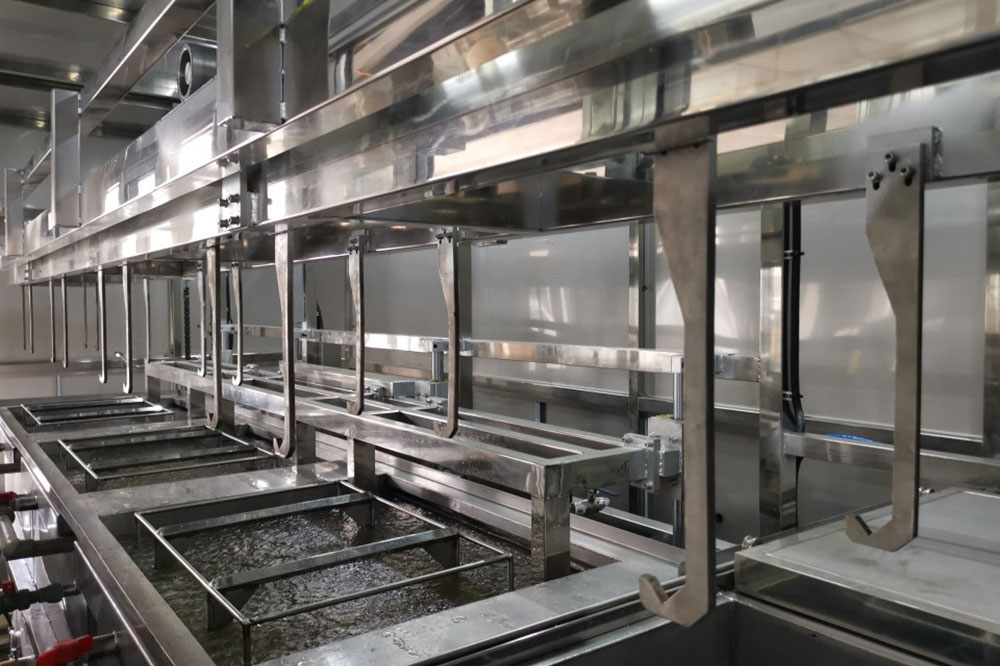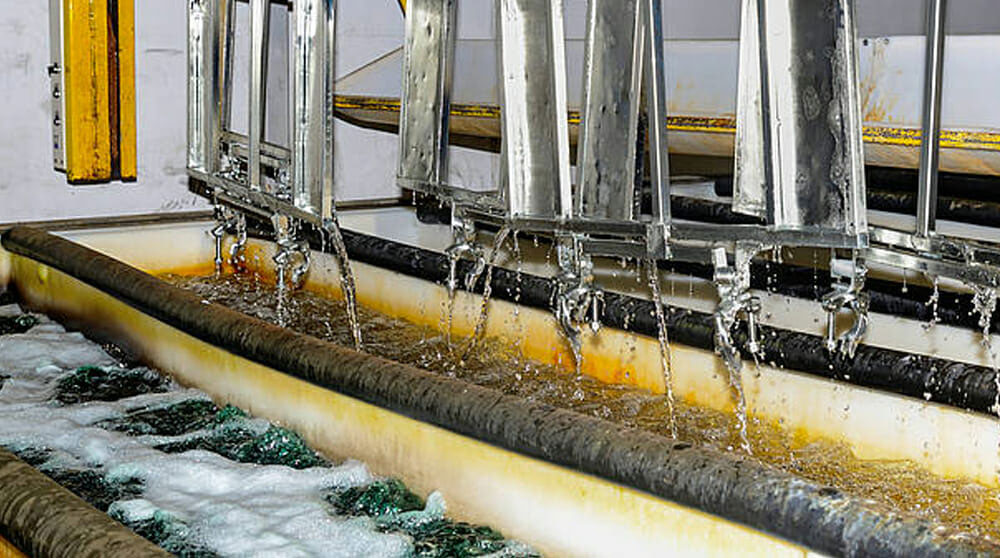- Information Classification
Degreasing Process Before Electroplating in 2025
Author | Zhengqiang Industry Insights Team
Updated | October 2025
Understanding the Principle of Coating Adhesion Between Plating and Metal Substrate
Master the degreasing process before electroplating. Learn how to improve coating adhesion, manage cleaning efficiency, and optimize surface treatment.
To effectively control and manage the degreasing process, it is essential to first understand the fundamental principle of adhesion between the metal coating and its substrate. This fundamental step is often overlooked in production, leading to adhesion failures and poor plating results.
Scientific studies show that mechanical adhesion between the coating and the microscopic uneven surface of the metal substrate alone is insufficient for a durable bond. True adhesion requires intermolecular and metallic bonding forces, which can only act at very short distances—typically within 5 micrometers.
If the surface of the substrate is covered with even a thin layer of oil film or oxide, these forces are blocked, preventing proper bonding. Therefore, achieving a clean and reactive surface through effective degreasing, rust removal, and oxide removal is critical before plating.
However, “completely clean” does not mean “absolutely spotless.” Instead, it refers to a functionally clean surface—one that is free of contaminants that interfere with plating, but still maintains a thin, uniform film that promotes adhesion.
In addition, the substrate must be mechanically smoothed through grinding, polishing, rolling, or sandblasting to remove burrs and scratches, ensuring the base meets the required flatness and finish standards before chemical pretreatment. Understanding these principles allows engineers to select appropriate pretreatment formulas and workflows for different materials and plating types.

Master the degreasing process before electroplating in Industrial Production
In most electroplating workshops, alkaline degreasing is the primary method used to remove oils and grease from metal surfaces. The composition and working conditions of the alkaline degreasing solution are chosen based on the type of metal and the degree of contamination.
-
For heavily greased surfaces (thick or sticky oil films), alkaline degreasing alone is insufficient. Pre-cleaning with organic solvents or mechanical brushing is recommended before immersion in alkaline solution.
-
Alkaline solutions are strongly caustic and can corrode certain metals. For example, aluminum and zinc should be treated under low-temperature and low-alkalinity conditions to prevent damage.
-
Steel parts, on the other hand, tolerate higher alkalinity and can be treated more aggressively. However, for non-ferrous metals like aluminum and zinc alloys, the pH should be kept below 11, and degreasing time should not exceed 3 minutes.
While lower temperatures reduce energy costs, they also slow down the reaction rate. Higher temperatures improve degreasing efficiency because heat lowers oil viscosity and enhances the emulsification process. In practice, maintaining 70–80°C provides optimal cleaning performance and even helps relieve residual machining stress, which improves coating adhesion—especially in multilayer nickel plating.
To further enhance results, electrolytic degreasing is often used:
-
For steel components, alternating cathodic (3–5 min) and anodic (1–2 min) degreasing ensures thorough cleaning.
-
High-strength steels and thin parts should use only anodic degreasing to prevent hydrogen embrittlement.
-
Copper and copper alloys must use cathodic degreasing only, as anodic methods can damage the surface.
Preparation and Maintenance of Degreasing Solutions
Proper preparation and management of degreasing solutions are essential for consistent performance and longevity.
-
Solution Preparation:
-
Dissolve all ingredients except surfactants in two-thirds of the tank volume filled with water.
-
Stir continuously to prevent clumping.
-
Surfactants should be pre-dissolved in hot water before adding to the main tank.
-
Adjust to the final working volume and mix thoroughly.
-
-
Solution Maintenance:
-
Conduct regular chemical analysis and replenish surfactants weekly or biweekly (adding ⅓ to ½ of the original dose).
-
Avoid using iron plates containing heavy metal impurities, as these can contaminate the plating layer.
-
Maintain current density between 5–10 A/dm² to generate sufficient hydrogen bubbles that help dislodge oil particles.
-
Remove floating oil regularly and clean sludge deposits from the tank bottom.
-
Replace the solution periodically to ensure consistent degreasing results.
-
Prefer low-foam surfactants to prevent contamination in subsequent plating baths.
-
These maintenance steps not only improve product quality but also extend bath life and reduce chemical waste and production cost.
Mastering and Managing the Acid Pickling Process
Just like degreasing, acid pickling (acid etching) plays an essential role in electroplating pretreatment. Its purpose is to remove rust and oxide layers from the metal surface, providing a clean, active surface ready for plating.
Acid pickling can be categorized into:
-
Strong etching: Removes heavy oxide scales.
-
Mild etching: Removes thin, invisible oxide films.
Weak etching usually follows strong etching and serves as the final surface activation step before electroplating. Neglecting this stage is a common cause of poor adhesion or plating blistering.
Choosing Between Sulfuric and Hydrochloric Acid Pickling
-
Sulfuric acid pickling:
-
Ideal concentration: 10–20%, temperature below 60°C.
-
Effective in removing scale, but solution performance decreases once Fe²⁺ exceeds 80 g/L.
-
Aged baths should be cooled and filtered before re-acidification.
-
-
Hydrochloric acid pickling:
-
Concentration typically 10–20% at room temperature.
-
Etching speed is 1.5–2 times faster than sulfuric acid under equal conditions.
-
However, hydrochloric acid vapors require strict ventilation to prevent air pollution.
-
Mixed Acids and Electrolytic Pickling
In some cases, mixed acids (e.g., sulfuric + hydrochloric) are used to combine the benefits of both—achieving faster cleaning with less hydrogen embrittlement.
For tight or complex oxide layers, electrolytic pickling provides superior cleaning with minimal base metal corrosion. This technique is especially effective in automated plating lines and can be implemented using cathodic, anodic, or periodic-reversal (PR) electrolysis methods.
Energy Efficiency and Process Optimization
While conventional degreasing and acid pickling are effective, they consume large amounts of electricity, heat, and chemicals. Studies show that in a medium-sized nickel-chrome plating line:
-
Electrolytic degreasing alone can account for 20% of total energy consumption.
-
Heating for chemical baths may consume 40–80% of total thermal energy.
To address this, modern factories are transitioning toward:
-
Low-temperature degreasing agents that work effectively at room temperature.
-
Energy-saving cleaners with built-in surfactants and corrosion inhibitors.
-
Integrated degreasing–derusting solutions that reduce process steps.
These innovations are non-toxic, efficient, and environmentally friendly, representing a major advancement in electroplating pretreatment technology.

The Importance of Proper Rinsing and Cleaning Techniques
After degreasing and pickling, thorough rinsing is critical to remove residual salts and chemicals. Poor rinsing can lead to plating defects such as pitting, peeling, or dullness.
-
Counterflow rinsing systems (multi-stage) save over 95% of water compared to single-tank rinsing.
-
Typically, a three-stage rinse system provides optimal results while allowing water recycling.
-
The rinse tanks should feature bottom-up water flow and optional air agitation or ultrasonic cleaning for even distribution.
Maintaining low levels of contaminants like chloride (Cl⁻) and sulfate (SO₄²⁻) is essential to prevent carryover into plating baths. This not only improves plating quality but also supports sustainable water management within the facility.
Conclusion: Master the degreasing process before electroplating
Mastering and managing the degreasing and acid pickling processes are strategically important for any electroplating factory. Continuous improvement in pretreatment technologies—along with scientific management and energy conservation—can significantly reduce defects, lower costs, and enhance the durability and aesthetic quality of plated products.
Zhengqiang Technology Group continues to research and implement advanced cleaning solutions and environmentally friendly technologies. Through collaboration among research, manufacturing, and application teams, we are committed to innovating new paths in electroplating pretreatment and delivering high-quality, sustainable surface finishing solutions for global clients.

